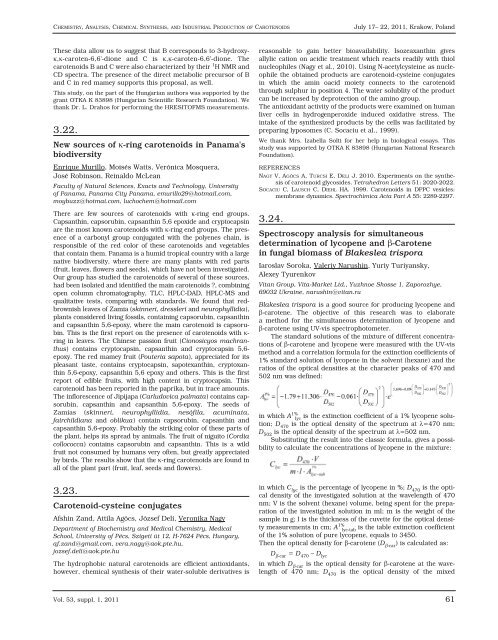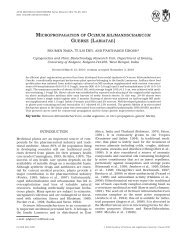ACTA BIOLOGICA CRACOVIENSIA
ACTA BIOLOGICA CRACOVIENSIA
ACTA BIOLOGICA CRACOVIENSIA
You also want an ePaper? Increase the reach of your titles
YUMPU automatically turns print PDFs into web optimized ePapers that Google loves.
CHEMISTRY, ANALYSIS, CHEMICAL SYNTHESIS, AND INDUSTRIAL PRODUCTION OF CAROTENOIDS<br />
These data allow us to suggest that B corresponds to 3-hydroxyκ,κ-caroten-6,6'-dione<br />
and C is κ,κ-caroten-6,6'-dione. The<br />
carotenoids B and C were also characterized by their 1H NMR and<br />
CD spectra. The presence of the direct metabolic precursor of B<br />
and C in red mamey supports this proposal, as well.<br />
This study, on the part of the Hungarian authors was supported by the<br />
grant OTKA K 83898 (Hungarian Scientific Research Foundation). We<br />
thank Dr. L. Drahos for performing the HRESITOFMS measurements.<br />
3.22.<br />
New sources of κ-ring carotenoids in Panama's<br />
biodiversity<br />
Enrique Murillo, Moisés Watts, Verónica Mosquera,<br />
José Robinson, Reinaldo McLean<br />
Faculty of Natural Sciences, Exacts and Technology, University<br />
of Panama, Panama City Panama, emurillo29@hotmail.com,<br />
moybuzz@hotmai.com, luchochem@hotmail.com<br />
There are few sources of carotenoids with κ-ring end groups.<br />
Capsanthin, capsorubin, capsanthin 5,6 epoxide and cryptocapsin<br />
are the most known carotenoids with κ-ring end groups. The presence<br />
of a carbonyl group conjugated with the polyenes chain, is<br />
responsible of the red color of these carotenoids and vegetables<br />
that contain them. Panama is a humid tropical country with a large<br />
native biodiversity, where there are many plants with red parts<br />
(fruit, leaves, flowers and seeds), which have not been investigated.<br />
Our group has studied the carotenoids of several of these sources,<br />
had been isolated and identified the main carotenoids ?, combining<br />
open column chromatography, TLC, HPLC-DAD, HPLC-MS and<br />
qualitative tests, comparing with standards. We found that redbrownish<br />
leaves of Zamia (skinneri, dressleri and neurophyllidia),<br />
plants considered living fossils, containing capsorubin, capsanthin<br />
and capsanthin 5,6-epoxy, where the main carotenoid is capsorubin.<br />
This is the first report on the presence of carotenoids with κring<br />
in leaves. The Chinese passion fruit (Cionosicyos machranthus)<br />
contains cryptocapsin, capsanthin and cryptocapsin 5,6epoxy.<br />
The red mamey fruit (Pouteria sapota), appreciated for its<br />
pleasant taste, contains cryptocapsin, sapotexanthin, cryptoxanthin<br />
5,6-epoxy, capsanthin 5,6 epoxy and others. This is the first<br />
report of edible fruits, with high content in cryptocapsin. This<br />
carotenoid has been reported in the paprika, but in trace amounts.<br />
The inflorescence of Jipijapa (Carludovica palmata) contains capsorubin,<br />
capsanthin and capsanthin 5,6-epoxy. The seeds of<br />
Zamias (skinneri, neurophyllidia, nesófila, acuminata,<br />
fairchildiana and oblikua) contain capsorubin, capsanthin and<br />
capsanthin 5,6-epoxy. Probably the striking color of these parts of<br />
the plant, helps its spread by animals. The fruit of niguito (Cordia<br />
collococca) contains capsorubin and capsanthin. This is a wild<br />
fruit not consumed by humans very often, but greatly appreciated<br />
by birds. The results show that the κ-ring carotenoids are found in<br />
all of the plant part (fruit, leaf, seeds and flowers).<br />
3.23.<br />
Carotenoid-cysteine conjugates<br />
Afshin Zand, Attila Agócs, József Deli, Veronika Nagy<br />
Department of Biochemistry and Medical Chemistry, Medical<br />
School, University of Pécs, Szigeti út 12, H-7624 Pécs, Hungary,<br />
af.zand@gmail.com, vera.nagy@aok.pte.hu,<br />
jozsef.deli@aok.pte.hu<br />
The hydrophobic natural carotenoids are efficient antioxidants,<br />
however, chemical synthesis of their water-soluble derivatives is<br />
Vol. 53, suppl. 1, 2011<br />
reasonable to gain better bioavailability. Isozeaxanthin gives<br />
allylic cation on acidic treatment which reacts readily with thiol<br />
nucleophiles (Nagy et al., 2010). Using N-acetylcysteine as nucleophile<br />
the obtained products are carotenoid-cysteine conjugates<br />
in which the amin oacid moiety connects to the carotenoid<br />
through sulphur in position 4. The water solublity of the product<br />
can be increased by deprotection of the amino group.<br />
The antioxidant activity of the products were examined on human<br />
liver cells in hydrogenperoxide induced oxidative stress. The<br />
intake of the synthesized products by the cells was facilitated by<br />
preparing lyposomes (C. Socaciu et al., 1999).<br />
We thank Mrs. Izabella Solti for her help in biological essays. This<br />
study was supported by OTKA K 83898 (Hungarian National Research<br />
Foundation).<br />
REFERENCES<br />
NAGY V, AGÓCS A, TURCSI E, DELI J. 2010. Experiments on the synthesis<br />
of carotenoid glycosides. Tetrahedron Letters 51: 2020-2022.<br />
SOCACIU C, LAUSCH C, DIEHL HA. 1999. Carotenoids in DPPC vesicles:<br />
membrane dynamics. Spectrochimica Acta Part A 55: 2289-2297.<br />
3.24.<br />
July 17– 22, 2011, Krakow, Poland<br />
Spectroscopy analysis for simultaneous<br />
determination of lycopene and β-Carotene<br />
in fungal biomass of Blakeslea trispora<br />
Iaroslav Soroka, Valeriy Narushin, Yuriy Turiyansky,<br />
Alexey Tyurenkov<br />
Vitan Group, Vita-Market Ltd., Yuzhnoe Shosse 1, Zaporozhye,<br />
69032 Ukraine, narushin@vitan.ru<br />
Blakeslea trispora is a good source for producing lycopene and<br />
β-carotene. The objective of this research was to elaborate<br />
a method for the simultaneous determination of lycopene and<br />
β-carotene using UV-vis spectrophotometer.<br />
The standard solutions of the mixture of different concentrations<br />
of β-carotene and lycopene were measured with the UV-vis<br />
method and a correlation formula for the extinction coefficients of<br />
1% standard solution of lycopene in the solvent (hexane) and the<br />
ratios of the optical densities at the character peaks of 470 and<br />
502 nm was defined:<br />
in which A1% lyc is the extinction coefficient of a 1% lycopene solution;<br />
D470 is the optical density of the spectrum at λ=470 nm;<br />
D502 is the optical density of the spectrum at λ=502 nm.<br />
Substituting the result into the classic formula, gives a possibility<br />
to calculate the concentrations of lycopene in the mixture:<br />
in which Clyc is the percentage of lycopene in %; D470 is the optical<br />
density of the investigated solution at the wavelength of 470<br />
nm; V is the solvent (hexane) volume, being spent for the preparation<br />
of the investigated solution in ml; m is the weight of the<br />
sample in g; l is the thickness of the cuvette for the optical density<br />
measurements in cm; A 1% lyc-tab is the table extinction coefficient<br />
of the 1% solution of pure lycopene, equals to 3450.<br />
Then the optical density for β-carotene (Dβ-car ) is calculated as:<br />
D β-car = D 470 – D lyc<br />
in which D β-car is the optical density for β-carotene at the wavelength<br />
of 470 nm; D 470 is the optical density of the mixed<br />
61












